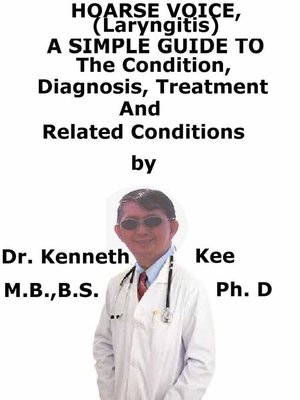Hoarse Voice (Laryngitis) a Simple Guide to the Condition, Diagnosis, Treatment and Related Conditions
ebook
By Kenneth Kee

Sign up to save your library
With an OverDrive account, you can save your favorite libraries for at-a-glance information about availability. Find out more about OverDrive accounts.
Find this title in Libby, the library reading app by OverDrive.



Search for a digital library with this title
Title found at these libraries:
| Library Name | Distance |
|---|---|
| Loading... |
Hoarseness of Voice (Laryngitis) is the medical inflammation of the mucous membranes of the Larynx which produces the sound of the voice.Laryngitis which continues beyond three weeks is described as chronic.Acute laryngitis is often due to infection but there are more infrequent causes.The basic pathophysiology of acute laryngitis is inflammation of the mucosa lining the vocal folds and larynx.If infection is present, white cells group to eliminate infectious material from the area.The swelling (edema) of the laryngeal lining raises the amount of pressure needed to produce sound, resulting in dysphonia or aphonia.Alterations to the structure of the larynx may also lead to a lower volume of speech.Chronic laryngitis can be because of a range of different causes, such as reflux, allergy, trauma and autoimmune disease.Dependent on the cause, there may be laryngeal spasm, edema, hyperemia, inflammation and numerous alterations to the appearance of the laryngeal mucosal cells.Acute laryngitis1. Infection is the most frequent cause of acute laryngitis, with viral infection responsible for the majority of patients:2. Injury due to voice misuse3. Immunosuppression and the use of steroid inhalersChronic laryngitis1. Allergy - allergic rhinitis, asthma.2. Laryngopharyngeal reflux.3. Trauma.4. SmokingAcute laryngitis1. Hoarseness or a breathless voice.2. Pain or discomfort anteriorly in the neck.Diagnosis is by:Nasal and throat swabs and vocal cord biopsyCT and MRI scanningVideostroboscopy unit consists of a stroboscopic unit (light source and microphone), an endoscope, a video camera, and a video recorder that help in diagnosing vocal cysts, polyps and nodulesTreatmentResting the voice assists to decrease inflammation of the vocal cords.A humidifier may relieve the scratchy sensation that comes with laryngitis.Decongestants and pain medicines may alleviate the symptoms of an upper respiratory infection.Chronic laryngitis1. Voice hygiene methods (rest, moisture)2. Voice therapy - exercises with the help of a speech therapist may benefit in some patients.This alters voice usage to decrease trauma to the larynx.3. Treat the underlying condition where possible - e.g., GERD may require proper lifestyle advice and the use of proton pump inhibitorsLaparoscopic reflux surgery (laparoscopic fundoplication) may have a part to play in treatment.Antibiotic are normally not used because most infections are viral.Antibiotics may be useful in patients who have persistent fever (for more than 48 hours), purulent sputum, related distant disease or other disorders such as immune system deficiency.TABLE OF CONTENTIntroductionChapter 1 Hoarse Voice (Laryngitis)Chapter 2 CausesChapter 3 SymptomsChapter 4 DiagnosisChapter 5 TreatmentChapter 6 PrognosisChapter 7 Vocal Cord ParalysisChapter 8 Vocal Cord PolypEpilogue







